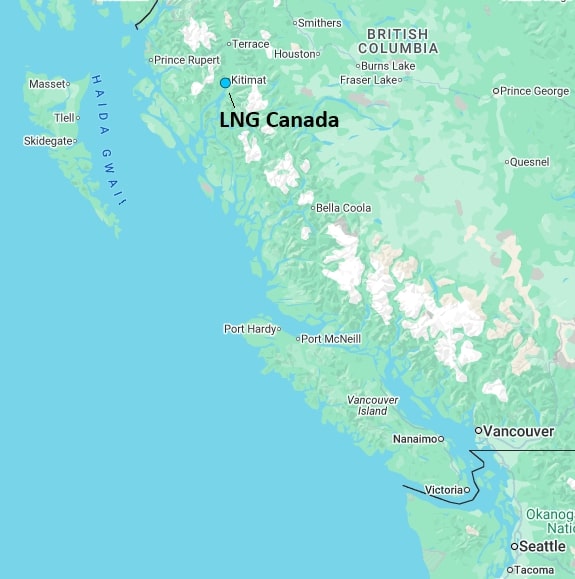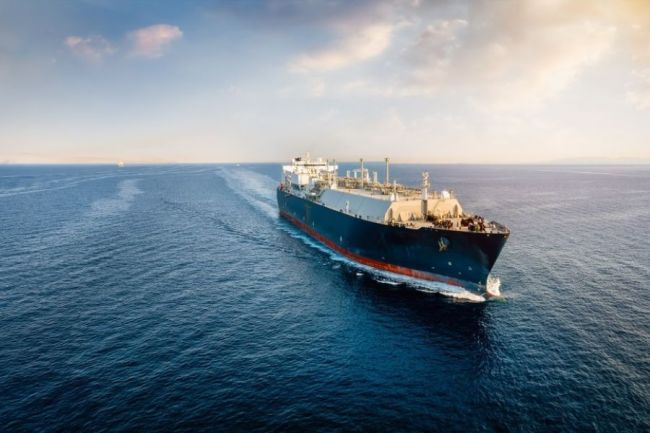LNG Canada shipped its first cargo on June 30, marking the country’s first concrete sale in the LNG export business.
LNG tanker Gaslog Glasgow arrived at the facility in Kitimat, British Columbia (B.C.), soon after the June 22 report that the plant had started LNG production. On July 1, the vessel had not yet cleared the outer islands on the country’s west coast and was headed toward the port of Incheon, South Korea, according to VesselFinder.com.
Shell, which owns the biggest stake in the company, celebrated the milestone in its announcement.
“LNG Canada grows our leading integrated gas portfolio, providing a reliable supply of LNG to markets most notably in Asia,” said Cederic Cremers, Shell’s president of integrated gas. “We expect that supplying LNG will be the biggest contribution Shell will make to the energy transition over the next decade, and projects like LNG Canada position our portfolio to achieve this.”
 Canada’s west coast is ideally suited for LNG production, with deepwater ports and nearby gas supplies. (Source: Rextag.)
Canada’s west coast is ideally suited for LNG production, with deepwater ports and nearby gas supplies. (Source: Rextag.)
The facility’s startup was also hailed by the country’s government leader. Canadian Prime Minister Mark Carney said the country could become the world’s “leading energy superpower” and strongest economy of the G7 nations.
“With LNG Canada’s first shipment to Asia, Canada is exporting its energy to reliable partners, diversifying trade and reducing global emissions—all in partnership with Indigenous Peoples,” Carney said in a statement. Native tribes own much of the land the facility and supporting infrastructure is located on.
Shell owns a 40% stake in LNG Canada. Other partners in the joint venture (JV) are Malaysia’s Petronas (25%), PetroChina (15%), Mitsubishi (15%) and Korea Gas (5%). The plant is operated through LNG Canada Development and is expected to produce about 14 million tonnes per year (mtpa) after fully ramping up operations.
The heavy Asian involvement in the project is not surprising, considering the potential customer base for the LNG produced there.
“Coastal B.C. is well-positioned for LNG export facilities due to its proximity to natural gas production and deepwater ports,” said Elle Caruso Fitzgerald, in an analysis for VettaFi. The geography of the region is similar to the U.S. Gulf Coast.
“However, B.C. offers the added benefit of faster shipping routes to Asian markets.”
LNG Canada is the country’s first export terminal. However, the nation is expected to quickly take a prominent role in global production, with two other projects, Woodfibre LNG and Cedar LNG, currently under construction. Another, Ksi Lisims LNG, is in development.
The LNG Canada JV is considering a Phase 2 expansion, which would bring the plant’s production up to 28 mtpa. The Ksi Lisims project will add 12 mtpa to the country’s output.
The other projects are smaller floating LNG terminals and will add about 5 mtpa combined.
For now, LNG Canada will continue production while making adjustments to the facility’s hardware.
The plant’s Train 1 did not start at full capacity, and it is challenging for analysts to determine the current natural gas usage of the facility.
“Physical flows to the facility remain unclear, as we are only able to monitor gas through two publicly available meters,” wrote A.J. O’Donnell, analyst for TPH & Co. The monitored flows account for about a third of the available supply to the Kitimat plant.
However, natural gas prices, as measured from the region’s AECO standard, are likely to remain flat throughout the summer, O’Donnell said, as the plant continues to ramp up operations. The AECO spot price was about $0.13/MMBtu on June 25.
